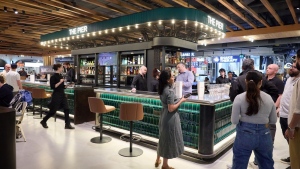Food halls have become a popular trend in the food industry, and it seems like they are just getting started. These communal dining spaces, which offer a variety of food options from different vendors, have been gaining traction in recent years and show no signs of slowing down.
According to a report by Cushman & Wakefield, there are currently over 200 food halls in the United States, with more than 100 in the works. This growth is expected to continue, with the report predicting that there will be over 300 food halls by 2020.
The concept of food halls originated in Europe, where they have been a staple for decades. However, it wasn’t until recently that they started gaining popularity in North America. The first food hall in the United States, Eataly, opened in New York City in 2010 and has since expanded to multiple locations across the country.
One of the main reasons for the success of food halls is the variety of options they offer. Customers can choose from a wide range of cuisines, from traditional to fusion, all in one location. This allows for a unique dining experience and caters to a diverse group of people with different tastes.
Food halls also provide a platform for small and local businesses to showcase their food and gain exposure. This not only benefits the vendors but also adds to the overall appeal of the food hall, as customers are always looking for new and unique dining experiences.
Another factor contributing to the growth of food halls is the rise of food delivery services. With the increasing popularity of apps like UberEats and DoorDash, food halls have become a convenient option for customers who want to try different foods without leaving their homes.
Despite the success of food halls, there are some challenges that come with this concept. One of the main concerns is the high rent and operating costs for vendors, which can make it difficult for them to turn a profit. However, with the right business model and a strong customer base, food halls can be a profitable venture for both vendors and developers.
In conclusion, food halls have become a popular trend in the food industry, and their growth shows no signs of slowing down. With their diverse food options, support for small businesses, and convenience for customers, it’s no surprise that this concept has caught on. As the industry continues to evolve, we can expect to see even more innovative and exciting food halls in the future.



